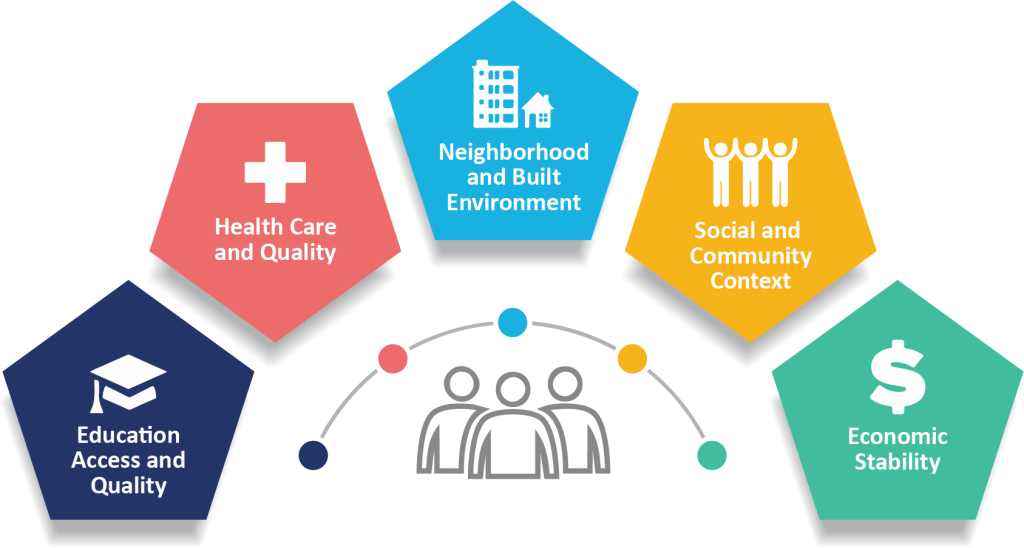
Guiding Hospital Planning and Design
The concept of social determinants of health (SDOH) is not new, but its significance has gained fresh momentum in recent years, particularly in the context of hospital planning and design. Understanding and addressing SDOH is no longer an option but a necessity for healthcare facilities aiming to provide equitable, patient-centred care.
What Are Social Determinants of Health?

Social determinants of health are the conditions in which people are born, grow, live, work, and age, along with the wider set of forces and systems shaping the conditions of daily life. These determinants encompass a broad range of factors, including:
- Economic Stability: This factor encompasses income levels, stable employment opportunities, and access to financial resources. Economic stability significantly influences an individual’s access to healthcare and overall well-being.
- Education: Education refers to both the level of educational attainment and access to quality educational resources. Higher education levels are often associated with better health outcomes, and access to quality education is crucial for making informed health decisions.
- Social and Community Context: Social integration, community support, and relationships within a community play a vital role in shaping health outcomes. Strong social connections and supportive communities can contribute to better mental and physical health.
- Healthcare Access and Quality: The accessibility of healthcare services and the quality of care received are fundamental SDOH. Limited access to healthcare and disparities in care quality can have significant health implications.
- Neighbourhood and Built Environment: Housing conditions, neighbourhood safety, and access to green spaces like parks and recreational areas are all elements of the built environment. These factors can influence physical activity, safety, and overall well-being within a community.
The Importance of SDOH in Hospital Planning and Design
The importance of Social Determinants of Health (SDOH) in hospital planning and design cannot be overstated. SDOH encompasses a wide range of factors that influence an individual’s health and well-being, and they extend far beyond the medical care provided within the hospital walls. Here’s why SDOH are crucial in shaping hospital planning and design:
- Equity and Accessibility: SDOH emphasize the need for equitable access to healthcare. Hospital planning and design must consider the socio-economic disparities that affect a community. By addressing SDOH, hospitals can ensure that their facilities are accessible and welcoming to all, regardless of income, education, or social status.
- Community-Centred Care: Hospitals are increasingly recognizing the importance of community-centred care. Understanding the social and community context of the population they serve allows hospitals to tailor their services to meet the specific needs of the community. This may involve offering culturally sensitive care, support services, or outreach programs.
- Preventive Care: SDOH emphasize the value of preventive care. Hospitals can incorporate spaces and programs that promote health education, wellness, and lifestyle improvements. This proactive approach aligns with addressing SDOH factors like education and neighbourhood environments.
- Holistic Healing Environments: Hospital design can influence a patient’s healing experience. By considering SDOH, hospitals can create environments that promote emotional well-being and patient dignity. Features like healinggardens, comfortable waiting areas, and private spaces for sensitive discussions contribute to holistic healing.
- Reducing Health Disparities: Hospitals play a critical role in reducing health disparities. By addressing SDOH, they can implement strategies to mitigate disparities in healthcare access and outcomes. This includes providing services that target vulnerable populations and addressing barriers to care.
- Patient Engagement and Empowerment: Hospitals can empower patients to take control of their health by providing education and resources related to SDOH. This not only improves patient engagement but also equips individuals with the knowledge and skills to address SDOH in their lives.
- Community Partnerships: Hospitals can forge partnerships with community organizations and agencies to address SDOH collaboratively. These partnerships can extend the reach of hospitals into the community, offering support beyond traditional medical care.
- Data-Driven Decision-Making: To address SDOH effectively, hospitals must collect and analyze data related to their community’s needs and social determinants. This data-driven approach enables hospitals to make informed decisions about service offerings, outreach programs, and facility design.
- Enhancing Population Health: Hospitals are increasingly responsible for the health of their communities, not just treating illnesses. By integrating SDOH considerations into planning and design, hospitals can contribute to enhancing the overall health of their service areas.
- Financial Considerations: Addressing SDOH can have financial benefits for hospitals. It can reduce readmissions, enhance patient satisfaction, and improve population health, which, in turn, can positively impact the hospital’s financial performance.
Conclusion
Revisiting social determinants of health and integrating them into hospital planning and design is an essential step toward creating healthcare environments that promote equity, access, and patient-centred care. As hospitals evolve to meet the needs of diverse populations, the positive impact of SDOH-focused planning and design will continue to shape the future of patient care. Astron Hospital Planning and Design, with its expertise in healthcare facility development, offers comprehensive services aligned with SDOH principles, ensuring that healthcare spaces are not just healing environments but also catalysts for community well-being. To know more about Astron Hospital Planning and design, visit our website.




